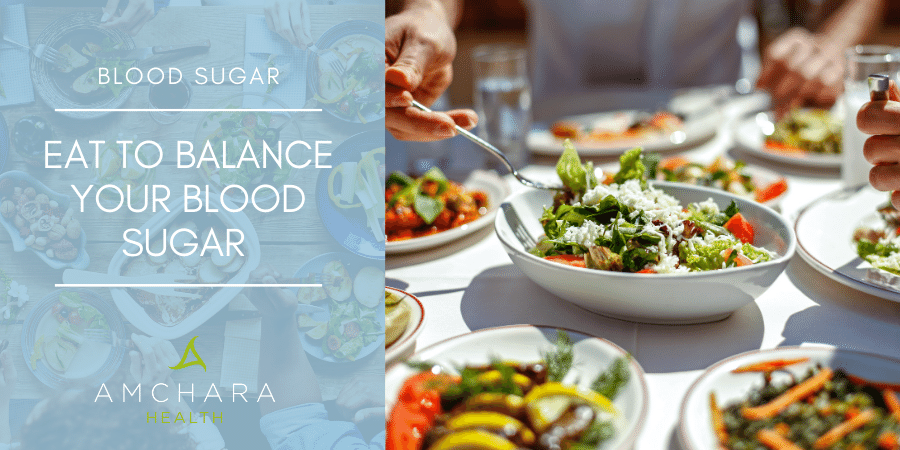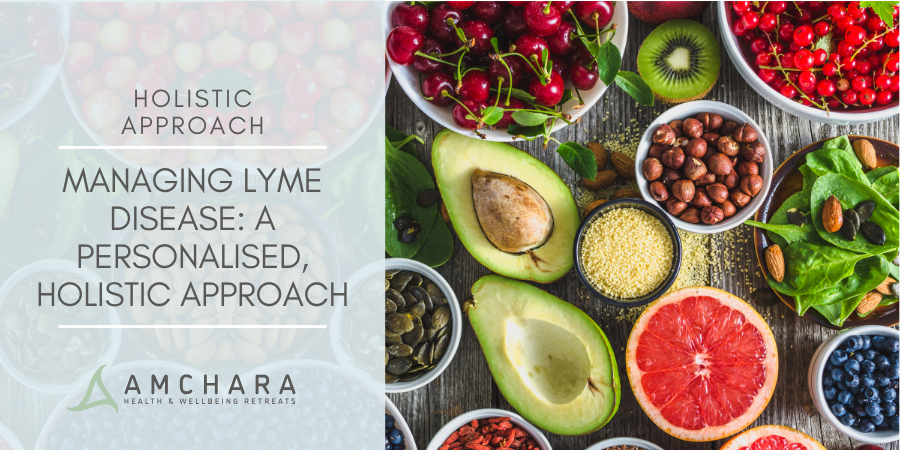Topics Covered in this article:
Balanced blood sugar levels are incredibly important for your overall health. As well as being protective against development of Type 2 diabetes, good blood sugar control plays a major role in weight management and the prevention of heart disease.
We always take an evidence-based approach and aim to provide you with actionable knowledge and tips to help you on your journey to optimal health. In this article we’re going to look at the relationship between food choices and blood sugar levels.
One of the easiest ways you can influence your blood sugar levels is through what you eat. Making small changes to your eating habits can have a surprisingly rapid impact on glucose control, so we’ll introduce you to some simple strategies to manage your blood sugar levels.
Blood sugar and food choices
Your body needs energy to survive, and it ultimately obtains this from glucose, extracted from food. Once glucose is absorbed into the blood, it’s carried to your body’s cells to be used for energy.
Foods vary as to how quickly they can be broken down by the body to release their stored glucose. If a food has had its fibre removed, or if it’s high in added sugar, glucose will be absorbed rapidly into the bloodstream, causing blood sugar levels to then rise very quickly.
In order to bring down elevated blood sugar, your pancreas will secrete insulin. If it’s constantly having to do this, its function may become impaired. It may secrete a little too much insulin, bringing sugar levels crashing down again quickly. This can leave you feeling jittery, weak and craving sugar. The temptation can then be to reach for a sweet snack, starting the cycle of blood sugar highs and lows.
If this situation is allowed to continue, eventually the pancreas will tire out completely and start to produce too little insulin. Blood sugar levels will then climb too high and Type 2 diabetes may develop.
Read on for some practical ways to make food choices to balance your blood sugar.
-
Avoid simple sugars and refined carbohydrates
Sugar exists in many forms in food. Its many disguises include glucose, sucrose, fructose, dextrose and lactose, but you’ll also see it listed as invert or inverted sugar, corn syrup and dextrin. In fact there are over 50 names commonly used for sugar in food manufacturing.
Simple sugars such as glucose, fructose and galactose consist of single molecules and are called monosaccharides. Two of these joined together are called disaccharides and include sucrose and maltose.
Simple sugars are very small molecules so they don’t need to be broken down a great deal by the body. This is why they typically release their energy rapidly into the bloodstream, causing spikes in blood sugar, followed by troughs if the body releases too much insulin.
On the other hand, complex carbohydrates are bigger molecules which need to be broken down by our digestive enzymes into glucose. This takes more time and so complex carbs have less of an immediate impact on blood sugar levels.
Many processed foods are loaded with simple sugars, so it’s a good habit to check labels. Low fat foods such as reduced fat yogurts often have sugar added to compensate for the flavour lost when the fat is removed.
Common culprits, high in simple sugars include many breakfast cereals, white bread, white rice, biscuits, baked beans, ready made sauces, tomato ketchup and even cooked meats. Watch out for honey, maple syrup and agave nectar as well as dried fruits which are high in sugar and best consumed in moderation.
-
Emphasise low glycaemic index carbs
The glycaemic index of a food, or GI, refers to the speed its energy is released into the bloodstream and in turn how quickly eating the food may cause blood sugar levels to rise. The idea is eating foods with a lower GI score will impact less on your blood glucose levels. Glucose itself has a GI score of 100.
The score is allocated after measurements of blood glucose before and after food has been eaten.
Foods with a score of 70 or above are likely to cause a rush of blood sugar followed by a crash, while foods with a score of under 50 provide steady energy with a slow increase in sugar levels and therefore don’t place as much strain on the pancreas. Those with a GI score of between 50 and 70 are thought to have a moderate impact on blood sugar.
Processed foods such as bread, cakes, biscuits and breakfast cereals are all high GI scorers. In contrast, pure protein foods containing no carbohydrate have a GI of zero.
The presence of fibre, protein or fat within carbohydrate-containing food naturally slows down sugar release, so the GI score will be lower. You might see these different carbohydrates referred to as fast or slow releasing carbs. Non starchy vegetables, nuts, seeds and pulses all have low GI ratings, while most fruit has a moderate GI score.
Generally, starchy vegetables have a higher GI rating. Some healthy foods are relatively high GI, such as sweet potatoes, especially if they’re baked, when the GI value rockets to 94 (1). However, sweet potatoes contain beneficial nutrients and antioxidants, so you don’t want to avoid them completely. The trick here is to combine fast releasing starchy vegetables with protein or fat to effectively slow the release of sugar.
You might also come across the glycaemic load rating of a food, which is an extension of the glycaemic index. This score has been developed to take into account the amount of carbohydrates in a typical serving of that food. It’s calculated by multiplying the GI by the amount of carbohydrate in a serving.
Glycaemic load can often give a more accurate picture than the glycaemic index, particularly when it comes to some foods like watermelon which have a high GI rating but a low GL score – it’s all about how much carbohydrate would be contained in one serving.
-
Kick your sweet tooth
We’ve already mentioned sugar goes by many names. When trying to control their sugar intake, many people will turn to sugar substitutes. However, even some artificial sweeteners, such as sucralose, have been found to cause a rise in blood sugar and insulin (2).
It’s worth remembering many natural sugar substitutes marketed as being healthy such as coconut sugar, agave nectar and maple syrup will still have an effect on blood sugar levels. But they also contain minerals such as zinc, important for the process of glucose management, as well as some fibre which slows the sugar release, reducing the GI score slightly.
One alternative is xylitol, a natural sugar alcohol found in some fruits and vegetables. It has been shown in studies to have very little impact on blood sugar levels. It looks like caster sugar and it can be used in baking and to sweeten drinks.
It can be difficult to give up sugar, as it’s thought to be even more rewarding and addictive than cocaine (3). Many of us are so used to eating foods with added sugar we’ve lost touch with the natural sweetness of foods.
One problem with replacing sugar with other sweeteners, even if they don’t raise insulin, is you’re continuing to encourage your body to expect sweet-tasting foods.
Cut sugar down or out for a set period and you’ll probably find you no longer crave it as your sweet tooth is recalibrated. This is partly because as your blood sugar stabilises, your brain no longer sends such a strong message that it urgently needs energy in the form of sugar.
-
Avoid excess fructose
Fructose is fruit sugar. It’s a simple sugar, but it needs to be converted into glucose by the liver before it can be used for energy. For this reason fructose has less of an impact on blood sugar levels.
However, consuming high levels of fructose can interfere with the message of insulin and contribute to disordered blood sugar control. This doesn’t mean we should avoid fruit, in which fructose is naturally packaged with other nutrients. One problem with fructose is it’s contained in a sweetener called high fructose corn syrup (HFCS), an ingredient found in many processed foods. HFCS is widely used because it is inexpensive, and is a common ingredient in many soda drinks, canned fruit, sauces, breakfast cereal and granola bars.
Avoiding sweetened drinks and processed foods containing HFCS will go a long way towards reducing your fructose consumption.
-
Consider low carb
For some people, the pancreas can overreact even to low GI carbohydrates. In this case, while blood sugar levels are stabilising, such people often feel much better if carbohydrates are reduced to a low level. Research has found the ketogenic diet, which includes only very few carbohydrates, can increase insulin sensitivity by increasing levels of a protein involved in blood sugar regulation (4).
The principle behind ketogenic eating is to reduce carbohydrates to as little as 20-30g per day, with higher levels of protein and especially fat. This causes the body to obtain energy from fat rather than glucose.
Although a ketogenic diet can be a healthy approach to eating, if you are thinking of investigating whether it may benefit you, it’s advisable to consult a Personalised Health practitioner.
-
Emphasise fibre
If the beneficial fibre in food is removed, the GI ranking increases and sugar is released rapidly into the bloodstream, because fibre slows sugar absorption from the gut. It’s thought our Palaeolithic ancestors consumed as much as 100g fibre per day. Nowadays the average intake in the UK is just under 19g per day.
The fibre in whole foods like oats, berries, fruits – especially apples – nuts and seeds, beans, pulses, lentils and many vegetables is soluble fibre, especially beneficial in regulating blood sugar levels.
Research is now discovering our microbiome, the population of bacteria residing in the gut, can influence glucose metabolism. Fibre is beneficial in maintaining a healthy balance of gut bacteria.
-
Don’t overlook protein
Eating protein, especially at breakfast, can help normalise blood sugar levels by slowing the absorption of sugar. Try to include protein with every meal.
Choose from wild-caught oily fish, organically reared chicken, nuts, seeds, beans and peas. At breakfast try a smoothie with added hemp, whey or pea protein powder.
-
Enjoy healthy fats
The presence of fat in or with food decreases the rate at which sugar is released into the blood. It’s also believed fats can affect blood sugar levels as they are incorporated into cell membranes and so influence how cells respond to insulin.
Some saturated fats have been shown to decrease insulin sensitivity (5). Saturated fat is found in meat and dairy products. But remember all saturated fats are not alike. Coconut oil contains fats known as medium chain triglycerides, which can be used by the liver directly for energy and have been found to exert beneficial effects on blood glucose control, although further research is needed.
On the other hand, monounsaturated fats, found in olive oil, nuts and avocados can assist with blood sugar control, as can unsaturated fats such as omega-3 fats from oily fish, flax oil, pumpkin seeds and walnuts.
-
Try not to snack
Although it was previously believed the answer to regular blood sugar levels lay in snacking frequently, we now know people who eat fewer, larger meals have more steady blood glucose levels than those who don’t (6).
If you feel your blood sugar dropping between meals, have a protein snack which will impact far less on your glucose levels than a high carbohydrate option.
-
Avoid stimulants
Caffeine, alcohol and smoking all encourage the production of adrenaline and therefore raise blood sugar levels by mobilising stored energy from the liver. This brings about the release of insulin, resulting in glucose peaks and troughs.
Although some studies suggest coffee drinkers are less likely to suffer from Type 2 diabetes, coffee is known to raise blood sugar, and we don’t yet know the full picture of the relationship between caffeine and glucose levels. One study showed drinking decaffeinated coffee interfered with glucose metabolism because decaf contains stimulants other than caffeine (7).
Stick to herbal teas, hot water and lemon, rooibos tea or barley coffee. Or try a delicious turmeric latte made with coconut milk, turmeric, black pepper and ginger.
Takeaway
Adopting the above measures is a great start in your journey towards balanced blood sugar. Even small changes can have an impact, so why not begin today? Once your blood glucose levels are more stable, you’ll be rewarded with increased energy, fewer cravings and clearer thinking, which will provide you with the motivation to implement further strategies to support your blood sugar.
Please remember these guidelines are general recommendations only and may not suit everybody, particularly those with specific health issues. In particular, if you are taking medication for diabetes do not alter the dose without consulting your GP.
If you would like to further explore how nutritional changes could benefit your health, a consultation with an Amchara Personalised Health practitioner could be useful.
Did you find this article informative?
What are your strategies for balancing your blood sugar?
With your help let’s continue the conversation. Please share your thoughts in the comments.
Read this next:




